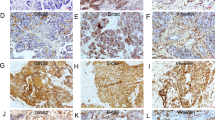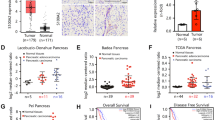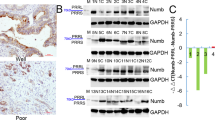Abstract
STMN2, as a key regulator in microtubule disassembly and dynamics, has recently been shown to participate in cancer development. However, the corresponding role in pancreatic ductal adenocarcinoma (PC), to our knowledge, has not been reported yet. In the current study, we systematically investigate the potential role of STMN2 in the progression of PC in vitro and vivo. Overexpression of STMN2 was prevalently observed in 81 human cases of PC tissues compared with that in the paired adjacent pancreas (54.3% vs 18.5%, P < 0.01), which was positively associated with multiple advanced clinical stages of PC patients (tumor size, T stage, lymph-node metastasis and the poor prognosis). Meanwhile, a close correlation between high STMN2 and cytoplasmic/nuclear β-catenin expression (P = 0.007) was observed in PC tissues and cell lines. STMN2 overexpression induced EMT and cell proliferation in vitro via stimulating EMT-like cellular morphology, cell motility and proliferation, and the change of EMT (Snail1, E-cadherin and Vimentin) and Cyclin D1 signaling. However, XAV939 inhibited STMN2 overexpression-enhanced EMT and proliferation. Conversely, KY19382 reversed STMN2 silencing- inhibited EMT and cell proliferation in vitro. Furthermore, activated STMN2 and β-catenin were co-localized in cytoplasm/nuclear in vitro. β-catenin/TCF-mediated the transcription of STMN2 by the potential binding sites (TTCAAAG). Finally, STMN2 promoted subcutaneous tumor growth following the activation of EMT and Cyclin D1 signaling. STMN2 overexpression promotes the aggressive clinical stage of PC patients and promotes EMT and cell proliferation in vitro and vivo. β-catenin/TCF-mediated the transcription of STMN2.
This is a preview of subscription content, access via your institution
Access options
Subscribe to this journal
Receive 12 print issues and online access
$259.00 per year
only $21.58 per issue
Buy this article
- Purchase on Springer Link
- Instant access to full article PDF
Prices may be subject to local taxes which are calculated during checkout








Similar content being viewed by others
Data availability
The datasets used and/or analyzed during the current study are available from the corresponding author on reasonable request.
References
Survival Rates for Pancreatic Cancer. https://www.cancer.org/cancer/pancreatic-cancer/detection-diagnosisstaging/survival-rates.html. Accessed 15 March 2021.
Sung H, Ferlay J, Siegel RL, Laversanne M, Soerjomataram I, Jemal A, et al. Global cancer statistics 2020: GLOBOCAN Estimates of Incidence and Mortality Worldwide for 36 Cancers in 185 Countries. CA Cancer J Clin. 2021;71:209–49.
Khalaf N, El-Serag HB, Abrams HR, Thrift AP. Burden of pancreatic cancer: from epidemiology to practice. Clin Gastroenterol Hepatol. 2020;19:876–84.
Luu T. Epithelial-mesenchymal transition and its regulation mechanisms in pancreatic cancer. Front Oncol. 2021;11:646399.
Grenningloh G, Soehrman S, Bondallaz P, Ruchti E, Cadas H. Role of the microtubule destabilizing proteins SCG10 and stathmin in neuronal growth. J Neurobiol. 2004;58:60–9.
Conde C, Caceres A. Microtubule assembly, organization and dynamics in axons and dendrites. Nat Rev Neurosci 2009;10:319–32.
Riederer BM, Pellier V, Antonsson B, Di Paolo G, Stimpson SA, Lutjens R, et al. Regulation of microtubule dynamics by the neuronal growth-associated protein SCG10, Proc. Natl Acad Sci USA. 1997;94:741–5.
Bieche I, Maucuer A, Laurendeau I, Lachkar S, Spano AJ, Frankfurter A, et al. Expression of stathmin family genes in human tissues: non-neural-restricted expression for SCLIP. Genomics. 2003;81:400–10.
Paradis V, Dargere D, Bieche Y, Asselah T, Marcellin P, Vidaud M, et al. SCG10 expression on activation of hepatic stellate cells promotes cell motility through interference with microtubules. Am J Pathol. 2010;177:1791–7.
Liu Z, Chatterjee TK, Fisher RA. RGS6 interacts with SCG10 and promotes neuronal differentiation. Role of the G gamma subunit-like (GGL) domain of RGS6. J Biol Chem. 2002;277:37832–9.
Zhong FJ, Sun B, Cao MM, Xu C, Li YM, Yang LY. STMN2 mediates nuclear translocation of Smad2/3 and enhances TGFβ signaling by destabilizing microtubules to promote epithelial-mesenchymal transition in hepatocellular carcinoma. Cancer Lett. 2021;506:128–41.
Rogers DA, Schor NF. Kidins220/ARMS depletion is associated with the neural-to Schwann-like transition in a human neuroblastoma cell line model. Exp Cell Res. 2013;319:660–9.
Prudencio M, Humphrey J, Pickles S, Brown AL, Hill SE, Kachergus JM, et al. Truncated stathmin-2 is a marker of TDP-43 pathology in frontotemporal dementia. J Clin Invest. 2020;130:6080–92.
Maleki Dana P, Sadoughi F, Mansournia MA, Mirzaei H, Asemi Z, Yousefi B. Targeting Wnt signaling pathway by polyphenols: implication for aging and age-related diseases. Biogerontology. 2021. https://doi.org/10.1007/s10522-021-09934-x.
Larue L, Bellacosa A. Epithelial-mesenchymal transition in development and cancer: role of phosphatidylinositol 3′ kinase/AKT pathways. Oncogene. 2005;24:7443–54.
Lee H-S, Lee DC, Park M-H, Yang S-J, Lee JJ, Kim DM, et al. STMN2 is a novel target of betacatenin/TCF-mediated transcription in human hepatoma cells. Biochem Biophys Res Commun. 2006;345:1059–67.
Lee H-S, Park M-H, Yang S-J, Park KC, Kim N-S, Kim Y-S, et al. Novel candidate targets of Wnt/betacatenin signaling in hepatoma cells. Life Sci. 2007;80:690–8.
Sheng W, Wang G, Tang J, Shi X, Cao R, Sun J, et al. Calreticulin promotes EMT in pancreatic cancer via mediating Ca2+ dependent acute and chronic endoplasmic reticulum stress. J Exp Clin Cancer Res. 2020;39:209.
Wang S, Wang T, Wang L, Zhong L, Li K. Overexpression of RNF126 promotes the development of colorectal cancer via enhancing p53 ubiquitination and degradation. Onco Targets Ther. 2020;13:10917–29.
Saukkonen K, Hagström J, Mustonen H, Juuti A, Nordling S, Kallio P, et al. PROX1 and β-catenin are prognostic markers in pancreatic ductal adenocarcinoma. BMC Cancer. 2016;16:472.
Kim K, Lu Z, Hay ED. Direct evidence for a role of beta-catenin/LEF-1 signaling pathway in induction of EMT. Cell Biol Int. 2002;26:463–76.
Huang L, Chen S, Fan H, Ji D, Chen C, Sheng W. GINS2 promotes EMT in pancreatic cancer via specifically stimulating ERK/MAPK signaling. Cancer Gene Ther. 2020. https://doi.org/10.1038/s41417-020-0206-7.
Zhang R, Gao X, Zuo J, Hu B, Yang J, Zhao J, et al. STMN1 upregulation mediates hepatocellular carcinoma and hepatic stellate cell crosstalk to aggravate cancer by triggering the MET pathway. Cancer Sci. 2020;111:406–17.
Zhang HQ, Guo X, Guo SQ, Wang Q, Chen XQ, Li XN, et al. STMN1 in colon cancer: expression and prognosis in Chinese patients. Eur Rev Med Pharm Sci. 2016;20:2038–44.
Suzuki K, Watanabe A, Araki K, Yokobori T, Harimoto N, Gantumur D, et al. High STMN1 expression is associated with tumor differentiation and metastasis in clinical patients with pancreatic cancer. Anticancer Res. 2018;38:939–44.
Bai T, Yokobori T, Altan B, Ide M, Mochiki E, Yanai M, et al. High STMN1 level is associated with chemo-resistance and poor prognosis in gastric cancer patients. Br J Cancer. 2017;116:1177–85.
Bao P, Yokobori T, Altan B, Iijima M, Azuma Y, Onozato R, et al. High STMN1 expression is associated with cancer progression and chemo-resistance in lung squamous cell carcinoma. Ann Surg Oncol. 2017;24:4017–24.
Jiang YG, Luo Y, He DL, Li X, Zhang LL, Peng T, et al. Role of Wnt/beta-catenin signaling pathway in epithelial-mesenchymal transition of human prostate cancer induced by hypoxia-inducible factor-1alpha. Int J Urol. 2007;14:1034–9.
Kaufhold S, Bonavida B. Central role of Snail1 in the regulation of EMT and resistance in cancer: a target for therapeutic intervention. J Exp Clin Cancer Res. 2014;33:62.
Stacey DW. Cyclin D1 serves as a cell cycle regulatory switch in actively proliferating cells. Curr Opin Cell Biol. 2003;15:158–63.
Montalto FI, De Amicis F. Cyclin D1 in cancer: a molecular connection for cell cycle control, adhesion and invasion in tumor and stroma. Cells. 2020;9:2648.
Acknowledgements
Thanks for the technical supports from both central laboratory and general laboratory at the First Hospital of China Medical University.
Author information
Authors and Affiliations
Contributions
Conception and design: MRS and SYW; acquisition of data: LW, QZ, and TLW; analysis and interpretation of data: MRS, LW, QZ, and TLW. writing, review, and revision of the manuscript: MRS and SYW.
Corresponding author
Ethics declarations
Competing interests
The authors declare no competing interests.
Ethics approval
The present study was approved by the Ethics Committee of the first hospital of China Medical University. The processing of clinical tissue samples is in strict compliance with the ethical standards of the Declaration of Helsinki. All patients signed written informed consent.
Additional information
Publisher’s note Springer Nature remains neutral with regard to jurisdictional claims in published maps and institutional affiliations.
Rights and permissions
Springer Nature or its licensor (e.g. a society or other partner) holds exclusive rights to this article under a publishing agreement with the author(s) or other rightsholder(s); author self-archiving of the accepted manuscript version of this article is solely governed by the terms of such publishing agreement and applicable law.
About this article
Cite this article
Shao, M., Wang, L., Zhang, Q. et al. STMN2 overexpression promotes cell proliferation and EMT in pancreatic cancer mediated by WNT/β-catenin signaling. Cancer Gene Ther 30, 472–480 (2023). https://doi.org/10.1038/s41417-022-00568-w
Received:
Revised:
Accepted:
Published:
Issue Date:
DOI: https://doi.org/10.1038/s41417-022-00568-w



